Introduction
AI adoption is rapidly gaining momentum in the automotive industry, transforming everything from vehicle design to supply chain operations. With growing investments in automation, data analytics, and autonomous technologies, automakers are embedding intelligence into every stage of the product lifecycle.
For businesses, AI offers tangible benefits: greater efficiency, enhanced safety, predictive insights, and more personalized customer experiences. This guide explores the key AI use cases driving innovation and performance across the automotive sector.
What is AI and Why Does It Matter in Automotive?
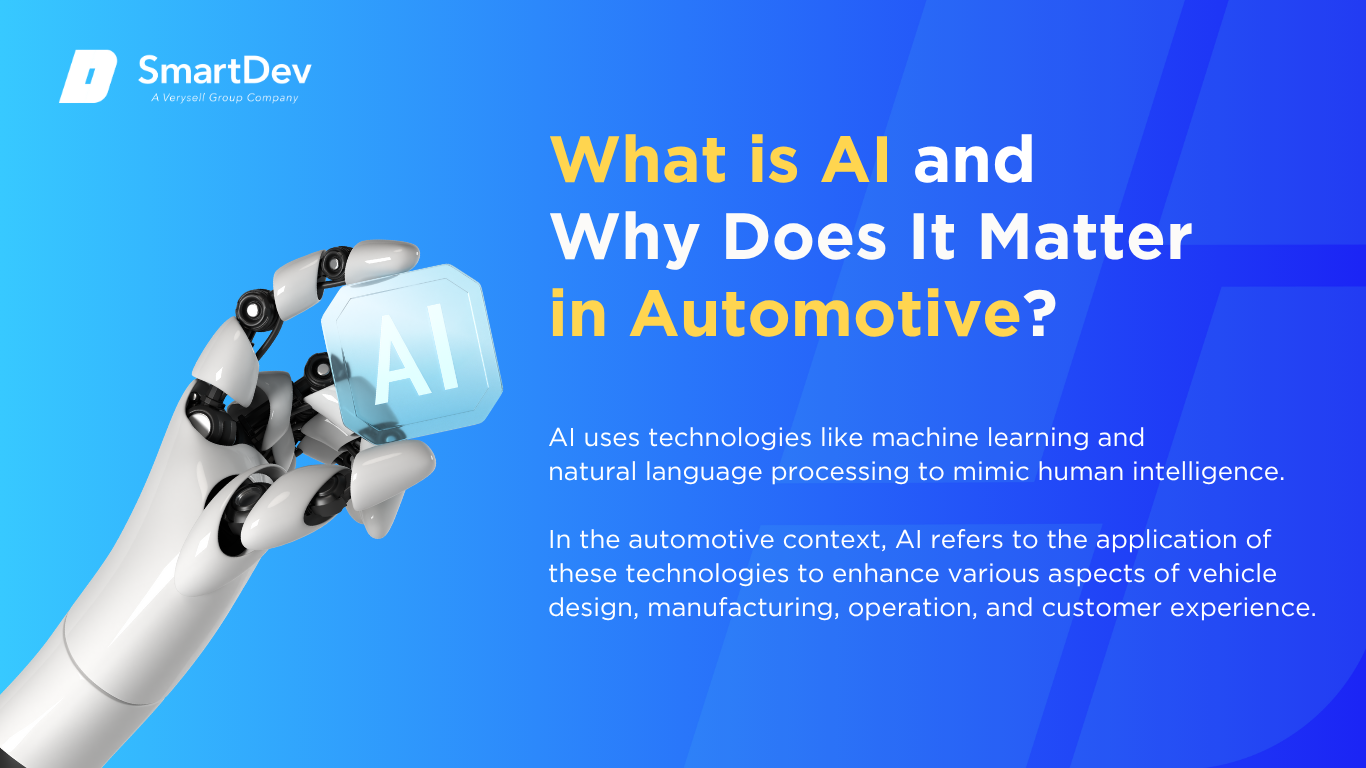
Definition of AI and Its Core Technologies
Artificial Intelligence (AI) encompasses computer systems designed to perform tasks that typically require human intelligence, such as learning, reasoning, problem-solving, and decision-making. Core technologies under the AI umbrella include machine learning, natural language processing (NLP), computer vision, and robotics.
In the automotive context, AI refers to the application of these technologies to enhance various aspects of vehicle design, manufacturing, operation, and customer experience. This includes autonomous driving systems, predictive maintenance, intelligent manufacturing, and personalized in-car experiences.
The Growing Role of AI in Transforming Automotive
AI is revolutionizing vehicle design and engineering by enabling rapid prototyping and simulation. For instance, Ford utilizes AI agents and NVIDIA GPUs to accelerate the design process, reducing tasks that previously took hours to mere seconds.
In manufacturing, AI-driven robots enhance precision and efficiency. General Motors collaborates with NVIDIA to implement AI in its assembly lines, improving productivity and quality control.
On the road, AI powers advanced driver-assistance systems (ADAS) and autonomous vehicles, enhancing safety and convenience. Companies like Mercedes-Benz and Google are integrating AI to develop self-driving technologies and improve navigation systems.
Key Statistics and Trends Highlighting AI Adoption in Automotive
The global AI in automotive market was valued at USD 4.8 billion in 2024 and is expected to reach USD 186.4 billion by 2034, growing at a CAGR of 42.8%. This surge reflects the industry’s increasing dependence on AI to boost efficiency, innovation, and competitiveness.
In the U.S., the AI automotive market surpassed USD 1 billion in 2024, signaling strong domestic investment. Automakers are rapidly scaling AI capabilities across vehicle design, manufacturing, and customer engagement.
A recent survey shows that 42% of automotive professionals are using AI in developing autonomous vehicles. This highlights the sector’s growing focus on self-driving technologies as a key area of innovation.
Business Benefits of AI in Automotive
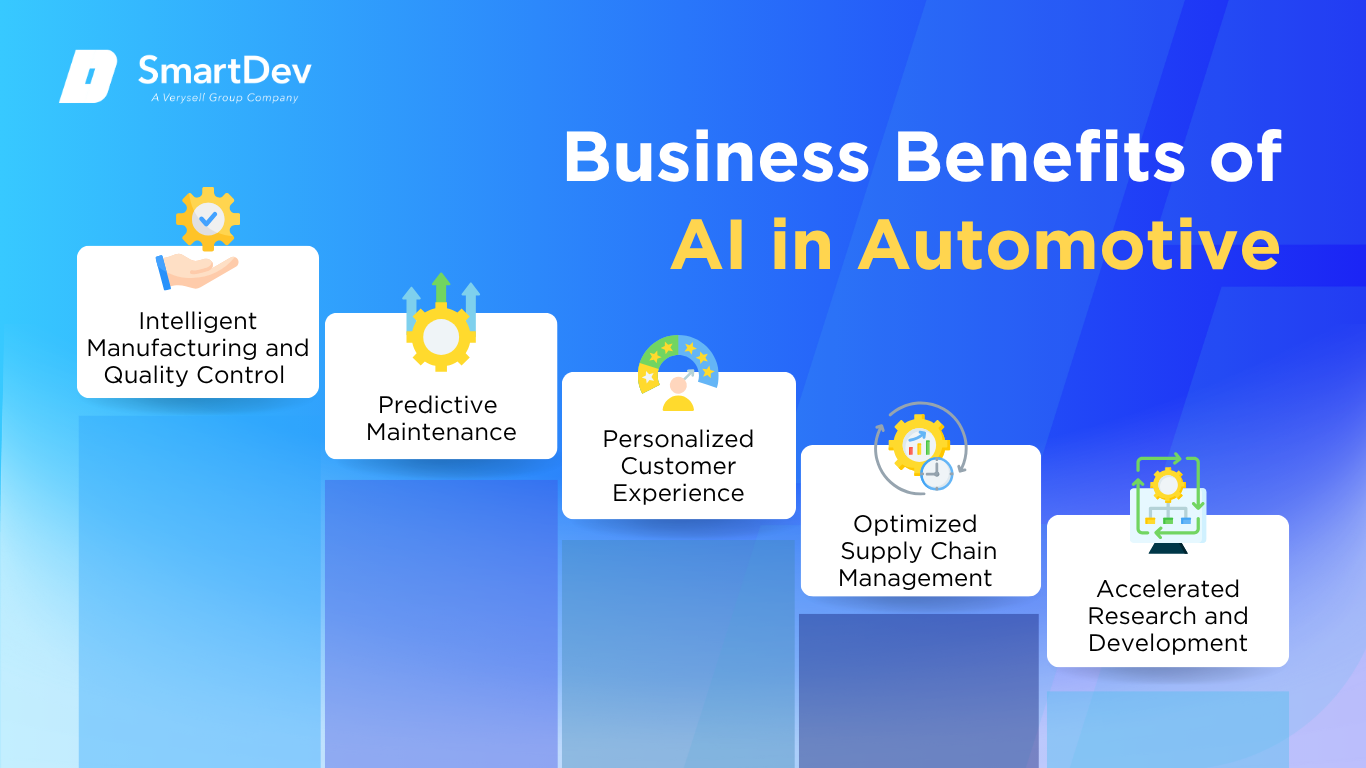
1. Intelligent Manufacturing and Quality Control
AI-driven automation and robotics are revolutionizing automotive manufacturing by optimizing production processes, reducing human error, and enhancing overall efficiency. Machine learning algorithms analyze vast amounts of data to identify inefficiencies, optimize assembly lines, and ensure precise quality control, leading to increased productivity and reduced costs.
For instance, AI-enabled 3D printing allows for quicker and more accurate production of complex automotive parts, reducing the time and labor required for traditional manufacturing methods. Additionally, AI enables predictive monitoring and can accurately detect defects in a vehicle, ensuring high-quality standards are maintained throughout the production process.
2. Predictive Maintenance and Vehicle Health Monitoring
AI enables predictive maintenance by analyzing vehicle data to anticipate and address potential issues before they lead to breakdowns. This proactive approach minimizes downtime, extends vehicle lifespan, and enhances customer satisfaction.
By leveraging AI algorithms, manufacturers can monitor various vehicle parameters in real-time, identifying patterns that indicate wear or potential failure. This allows for timely interventions, reducing repair costs and improving overall vehicle reliability.
For a deeper dive into how predictive maintenance is transforming manufacturing processes, check out our article on AI in predictive maintenance.
3. Personalized Customer Experience
AI enhances the in-car experience by learning driver preferences and tailoring settings like climate control, seating, and infotainment accordingly. This level of personalization improves comfort and convenience, making each drive feel uniquely customized.
Outside the vehicle, AI-driven assistants and predictive service reminders simplify interactions and anticipate needs. By delivering timely, relevant support, automakers boost customer satisfaction and build stronger brand loyalty.
4. Optimized Supply Chain Management
AI is transforming supply chain management in the automotive industry by enabling precise demand forecasting, inventory optimization, and enhanced production planning. These advancements lead to more efficient and cost-effective supply chains, benefiting both manufacturers and consumers.
By analyzing data from various sources such as social media, weather reports, and market trends, AI helps manufacturers make informed decisions regarding production, distribution, and pricing. This reduces the risk of human error and improves the overall efficiency and effectiveness of supply chain operations.
5. Accelerated Research and Development
AI accelerates research and development by facilitating rapid prototyping and testing. By simulating various scenarios and analyzing outcomes, AI enables engineers to refine designs and identify potential issues early in the development process.
This efficiency allows automakers to bring innovative products to market faster, maintaining a competitive edge. Additionally, AI-driven insights can inform strategic decisions, guiding investment in new technologies and features that align with consumer preferences and market trends.
Challenges Facing AI Adoption in Automotive
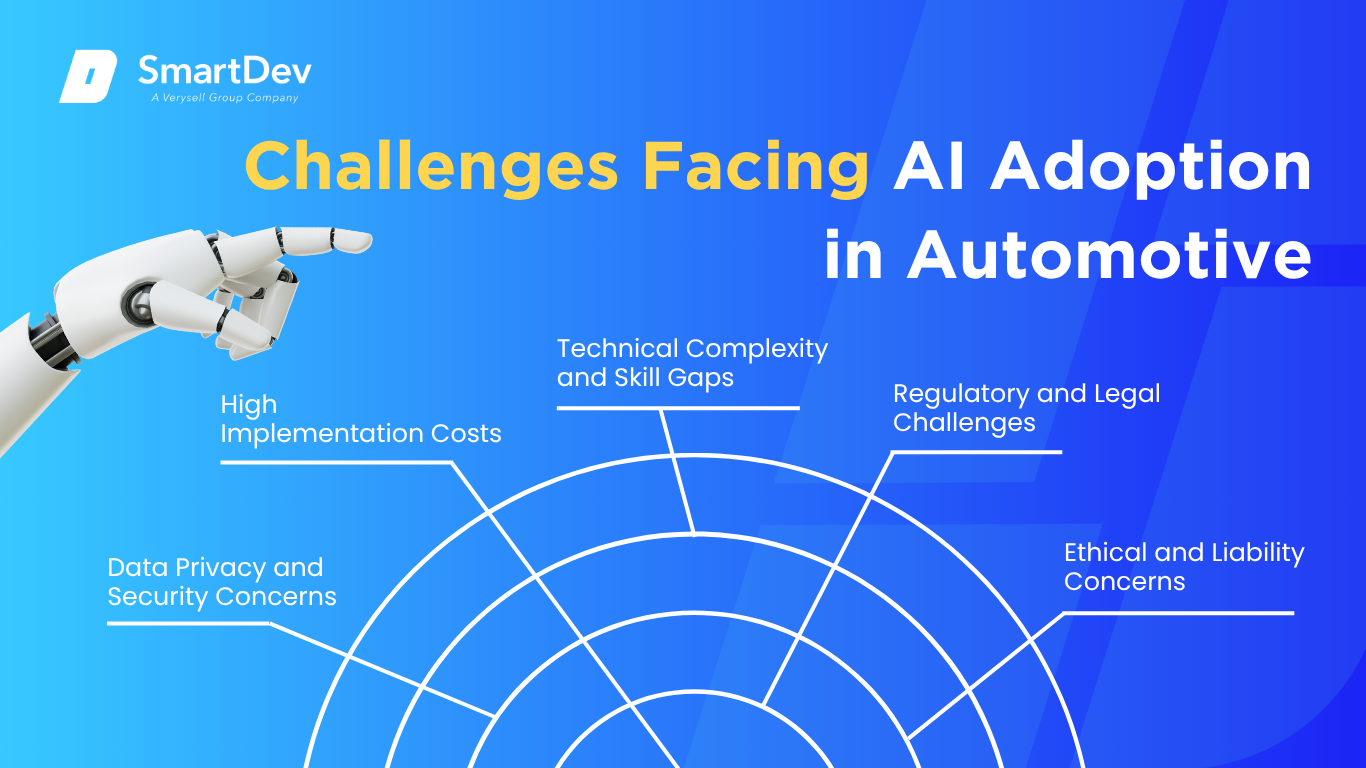
1. Data Privacy and Security Concerns
The integration of AI requires the collection and processing of vast amounts of data, raising concerns about data privacy and security. Ensuring compliance with regulations like GDPR and implementing robust cybersecurity measures are essential to protect sensitive information.
As vehicles become more connected, the risk of cyberattacks increases, necessitating the development of advanced security protocols and real-time threat detection systems to safeguard both user data and vehicle functionality.
If you’re exploring how to innovate with AI while maintaining data security and regulatory compliance, this article on balancing AI and data privacy offers practical guidance.
2. High Implementation Costs
Developing and deploying AI technologies involve significant investment in infrastructure, software, and skilled personnel. These high costs can be a barrier, especially for small and medium-sized enterprises.
The financial burden of integrating AI solutions may deter some companies from adopting these technologies, potentially leading to a competitive disadvantage in an industry increasingly driven by innovation and efficiency.
3. Technical Complexity and Skill Gaps
AI systems are complex and require specialized knowledge for development and maintenance. The shortage of AI expertise in the automotive sector can hinder implementation and scalability.
Addressing this challenge necessitates investment in workforce development, including training programs and partnerships with educational institutions to cultivate the necessary skills within the industry.
4. Regulatory and Legal Challenges
The evolving regulatory landscape for AI and autonomous vehicles presents challenges. Navigating varying regulations across regions requires careful planning and adaptation to ensure compliance and avoid legal issues.
Additionally, the lack of standardized regulations can create uncertainty, potentially slowing the adoption of AI technologies as companies await clearer guidelines and policies.
5. Ethical and Liability Concerns
The deployment of AI in vehicles raises ethical questions, particularly regarding decision-making in critical situations and the assignment of liability in the event of accidents. Determining who is responsible – the driver, manufacturer, or AI developer – can be complex and contentious.
These concerns necessitate the development of ethical frameworks and legal standards to guide the responsible implementation of AI in the automotive industry, ensuring public trust and acceptance.
Specific Applications of AI in Automotive
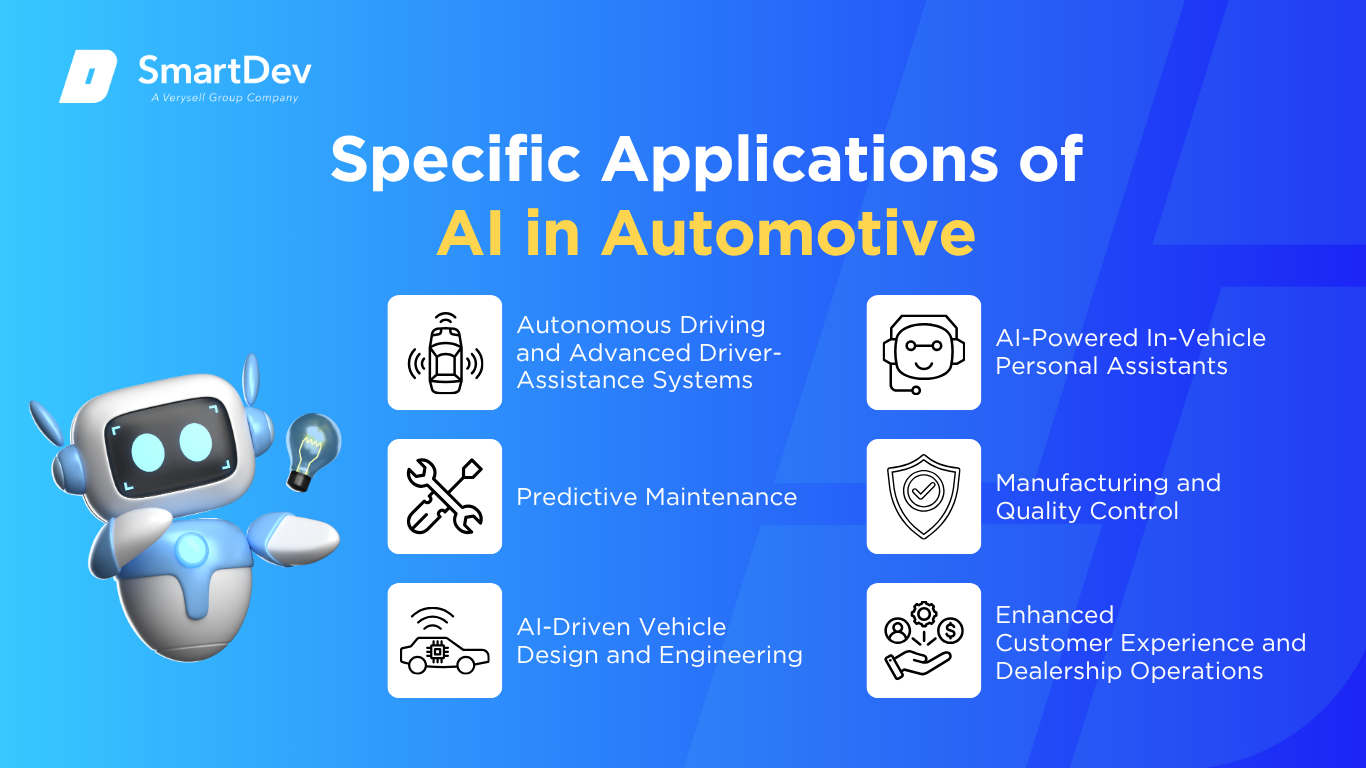
1. Autonomous Driving and Advanced Driver-Assistance Systems (ADAS)
Autonomous driving represents one of the most transformative applications of AI in the automotive sector. By leveraging machine learning algorithms and sensor data, vehicles can perceive their environment, make decisions, and navigate without human intervention. This technology addresses challenges such as reducing traffic accidents and improving mobility for those unable to drive.
AI systems in autonomous vehicles process inputs from cameras, LiDAR, radar, and ultrasonic sensors to create a comprehensive understanding of the vehicle’s surroundings. Deep learning models interpret this data to detect objects, predict movements, and plan safe paths. Integration with vehicle control systems allows for real-time responses to dynamic driving conditions.
The adoption of autonomous driving and ADAS enhances road safety, reduces driver fatigue, and optimizes traffic flow. Features like adaptive cruise control, lane-keeping assist, and automatic emergency braking are becoming standard, paving the way for fully autonomous vehicles.
Real-World Example:
Wayve, an AI startup backed by Nvidia and Microsoft, is collaborating with Nissan to integrate its autonomous driving software into Nissan’s ProPILOT system. Wayve’s approach relies on camera data and real-world testing, enabling vehicles to adapt like human drivers. This partnership aims to enhance collision avoidance and accelerate the development of Level 3 autonomy features.
2. Predictive Maintenance and Vehicle Health Monitoring
Predictive maintenance utilizes AI to anticipate vehicle component failures before they occur, minimizing downtime and repair costs. By analyzing data from various sensors, AI models can identify patterns indicative of wear or malfunction, allowing for timely interventions.
These systems collect data on engine performance, brake wear, battery health, and more. Machine learning algorithms process this information to predict when maintenance is needed, often alerting drivers through onboard systems or mobile apps. This proactive approach contrasts with traditional reactive maintenance strategies.
Implementing predictive maintenance improves vehicle reliability, extends component lifespan, and enhances customer satisfaction. It also enables manufacturers and fleet operators to optimize maintenance schedules and reduce operational costs.
Real-World Example:
Porsche has developed an AI-based predictive maintenance system for its Macan model, analyzing real-time diagnostic data to detect anomalies. The system alerts owners via an app, allowing for early intervention. This approach has led to significant savings on repair bills and is expected to expand to other models like the Taycan.
3. AI-Driven Vehicle Design and Engineering
AI is transforming vehicle design and engineering by enabling rapid prototyping and optimization. Generative design algorithms can explore numerous design variations, considering factors like aerodynamics, weight, and structural integrity, to identify optimal solutions.
These AI tools analyze vast datasets, including material properties and performance metrics, to suggest innovative designs. Engineers can simulate and test these designs virtually, reducing the need for physical prototypes and accelerating the development process.
The integration of AI in design leads to more efficient, lightweight, and high-performing vehicles. It also allows for greater customization and faster response to market demands.
Real-World Example:
Ford is utilizing AI agents and Nvidia GPUs to expedite vehicle design processes. By converting 2D sketches into 3D models and conducting stress analyses through AI, Ford has significantly reduced design cycle times. This approach enhances competitiveness and accelerates the introduction of new models.
4. AI-Powered In-Vehicle Personal Assistants
In-vehicle personal assistants powered by AI enhance driver experience by providing voice-activated controls, navigation assistance, and personalized recommendations. These systems use natural language processing to understand and respond to driver commands, improving convenience and safety.
AI assistants can adjust climate settings, control infotainment systems, and provide real-time traffic updates. By learning driver preferences and behaviors, they offer tailored suggestions and reminders, creating a more intuitive driving environment.
The adoption of AI assistants contributes to hands-free operation, reducing distractions and allowing drivers to focus on the road. It also opens avenues for integrating additional services and connectivity features.
Real-World Example:
IBM has partnered with Scuderia Ferrari to develop an AI-enhanced app that delivers personalized content and insights to fans. Utilizing IBM’s watsonx platform, the app processes over a million data points per second during races, transforming complex information into engaging user experiences.
To see how virtual assistants improve productivity beyond driving, our article on AI-powered assistants in the workplace will show you how.
5. Manufacturing and Quality Control
AI applications in manufacturing streamline production processes and enhance quality control. Machine learning algorithms analyze data from sensors and cameras to detect defects, monitor equipment performance, and optimize assembly lines.
Computer vision systems inspect components in real-time, identifying anomalies that may indicate quality issues. Predictive analytics forecast equipment failures, allowing for preemptive maintenance and reducing downtime.
Implementing AI in manufacturing leads to higher product quality, increased efficiency, and cost savings. It also supports flexible manufacturing systems capable of adapting to changing production requirements.
Real-World Example:
BMW employs AI-driven quality control systems in its manufacturing plants. These systems use computer vision to inspect vehicles for defects, ensuring high-quality standards and reducing the need for manual inspections. This approach has improved production efficiency and product reliability.
6. Enhanced Customer Experience and Dealership Operations
AI enhances customer experience by enabling personalized marketing, streamlined sales processes, and efficient dealership operations. By analyzing customer data, AI systems can tailor recommendations, predict purchasing behavior, and optimize inventory management.
Chatbots and virtual assistants provide instant responses to customer inquiries, schedule test drives, and assist with financing options. AI-driven analytics help dealerships understand market trends and customer preferences, informing strategic decisions.
These applications lead to improved customer satisfaction, increased sales conversions, and more efficient dealership operations.
Real-World Example:
AutomotiveMastermind utilizes AI to analyze customer data and predict buying behavior, enabling dealerships to target marketing efforts effectively. This approach has resulted in higher customer engagement and increased sales performance.
Examples of AI in Automotive
Real-World Case Studies
Real-world applications of AI in the automotive industry highlight its transformative power across design, maintenance, and driving systems. These examples offer actionable insights into how leading companies are leveraging AI to gain a competitive edge.

1. Ford: Accelerating Design with AI Agents
Ford is harnessing AI to accelerate its vehicle design processes with intelligent agents and high-performance GPUs. These AI agents convert 2D sketches into fully-formed 3D models and simulate real-world conditions to assess stress and durability. This automation drastically shortens the design cycle, allowing Ford to move from concept to prototype in seconds instead of hours.
The company integrates these AI tools directly into its engineering workflows, enabling rapid iteration and improved design quality. By minimizing manual work and enabling simultaneous evaluations, Ford can adapt quickly to market demands and technological changes. This approach not only increases efficiency but also provides a competitive edge in launching innovative vehicle models faster.
2. Porsche: Predictive Maintenance for Enhanced Reliability
Porsche’s AI-based predictive maintenance solution is revolutionizing how the company handles vehicle health monitoring. The system analyzes real-time diagnostic data to predict potential failures before they happen, alerting users through mobile applications. This proactive strategy reduces costly breakdowns and ensures a more seamless ownership experience for customers.
By adopting predictive analytics, Porsche has decreased service-related costs and enhanced vehicle uptime across its luxury lineup. This initiative supports customer loyalty and brand trust, positioning Porsche as a technology leader in after-sales innovation. The scalable system is also expected to extend across more models, reflecting its operational success.
3. Wayve and Nissan: Advancing Autonomous Driving
Wayve, a UK-based AI startup, is redefining autonomous driving by using a camera-first, AI-driven approach instead of relying heavily on LiDAR. In collaboration with Nissan, Wayve’s system leverages reinforcement learning and real-world data to train vehicles to adapt to unpredictable road conditions. This technique mimics human learning, enabling more fluid and intuitive driving behavior.
The technology is being integrated into Nissan’s ProPILOT system to enhance its semi-autonomous features. This partnership represents a shift toward software-defined vehicles where AI continuously evolves based on driving data. It marks a significant step forward in making safe, adaptable autonomous driving commercially viable.
Innovative AI Solutions
Emerging AI technologies are rapidly reshaping the automotive landscape, offering innovative solutions that span design, manufacturing, and cybersecurity. One significant advancement is the use of generative AI to build virtual environments for training autonomous vehicles. This enables safe, scalable, and cost-effective development without the need for extensive real-world testing.
In the realm of production, AI-powered robots with advanced vision capabilities are enhancing precision and flexibility on assembly lines. These intelligent systems can adapt to changing inputs, handle complex assembly tasks, and work collaboratively with humans. As a result, manufacturers benefit from greater efficiency, reduced error rates, and improved throughput.
AI is also playing a critical role in strengthening vehicle cybersecurity, particularly in connected and autonomous models. Machine learning algorithms monitor system behavior and network traffic to detect anomalies and prevent potential threats in real-time. These evolving solutions not only secure vehicle operations but also bolster consumer trust in increasingly digital automotive ecosystems.
AI-Driven Innovations Transforming Automotive
Emerging Technologies in AI for Automotive
Artificial Intelligence (AI) is reshaping the automotive landscape, introducing groundbreaking technologies that enhance vehicle design, manufacturing, and user experience. One notable advancement is the integration of Generative AI in automotive design processes. Ford Motor Company, for instance, leverages AI agents and Nvidia GPUs to accelerate vehicle design, reducing time-consuming tasks like clay modeling and extensive engineering simulations. This approach enables rapid generation of 3D models and stress predictions, significantly cutting down design time from hours to seconds.
Computer vision is another transformative AI application in the automotive sector. Companies like Smart Eye have developed Driver Monitoring Systems (DMS) that utilize AI-powered vision to assess driver attentiveness and emotional states. These systems analyze facial expressions and cognitive states in real-time, enhancing safety by detecting signs of drowsiness or distraction. Such technologies are becoming increasingly prevalent, with Smart Eye’s DMS already deployed in over 1 million vehicles globally.
AI’s Role in Sustainability Efforts
AI plays a pivotal role in advancing sustainability within the automotive industry. Predictive analytics powered by AI enables manufacturers to anticipate maintenance needs, reducing waste and improving efficiency. For example, AI-based predictive maintenance can lead to a 30% reduction in emissions and a 25% decrease in energy consumption, contributing to significant environmental and economic benefits.
Optimizing energy consumption is another area where AI demonstrates its value. Renault Group has integrated AI analytics to monitor and optimize energy usage in manufacturing processes, achieving substantial reductions of 25% in energy consumption and aiming for an additional 25% reduction by 2025. These efforts align with broader sustainability goals, showcasing AI’s capacity to drive eco-friendly innovations in automotive production.
How to Implement AI in Automotive
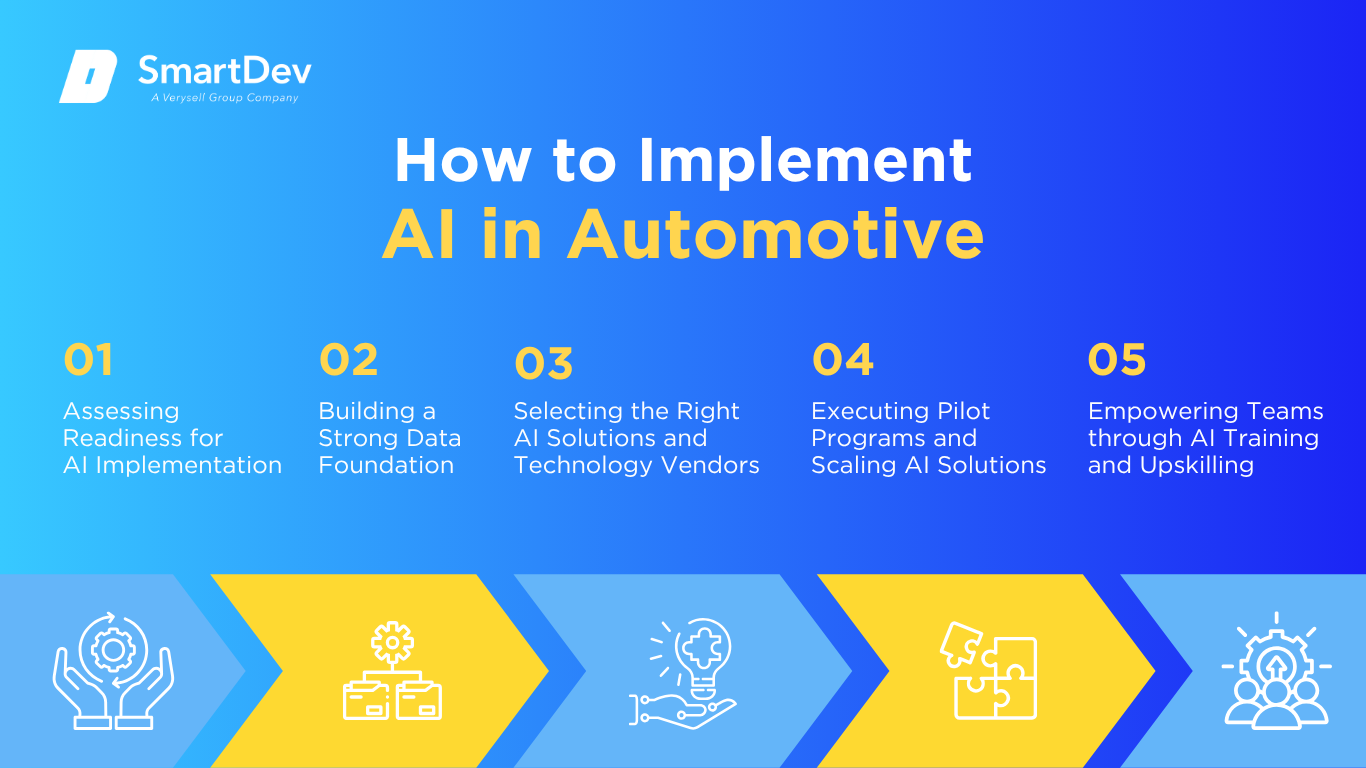
Step 1. Assessing Readiness for AI Adoption
Before integrating AI technologies, automotive companies must evaluate their readiness for adoption. This involves identifying business areas where AI can deliver the most value, such as design, manufacturing, customer service, or supply chain management. Understanding the specific challenges and opportunities within these domains helps in formulating a strategic AI implementation plan.
Assessing organizational culture and infrastructure is equally important. Companies need to ensure they have the necessary technological infrastructure, skilled personnel, and a culture that embraces innovation. This foundational assessment sets the stage for successful AI integration, aligning technological capabilities with business objectives.
Step 2. Building a Strong Data Foundation
A robust data foundation is critical for effective AI deployment. Automotive companies must focus on collecting high-quality data from various sources, including sensors, customer interactions, and operational processes. Ensuring data accuracy, consistency, and completeness is essential for training reliable AI models.
Implementing best practices in data management, such as data cleaning and governance, enhances the quality and usability of data. Establishing clear protocols for data storage, access, and security ensures that AI systems operate on trustworthy data, leading to more accurate insights and predictions.
Step 3. Choosing the Right Tools and Vendors
Selecting appropriate AI tools and vendors is a crucial step in the implementation process. Automotive companies should evaluate AI platforms based on their compatibility with existing systems, scalability, and the specific needs of the business. For instance, companies like Seez offer AI-powered solutions tailored for car dealerships, enhancing customer interactions and operational efficiency.
Collaborating with vendors that have a deep understanding of the automotive industry ensures that the AI solutions are aligned with industry-specific challenges and requirements. This strategic partnership facilitates smoother integration and maximizes the benefits derived from AI technologies.
Step 4. Pilot Testing and Scaling Up
Implementing AI should begin with pilot projects to test the technology’s effectiveness in a controlled environment. These pilots help in identifying potential issues, measuring performance, and gathering feedback for improvements. For example, General Motors has partnered with Nvidia to utilize AI in virtual assembly line simulations, aiming to reduce downtime and improve efficiency.
Successful pilot projects provide a blueprint for scaling up AI initiatives across the organization. By analyzing the outcomes and lessons learned from pilots, companies can refine their strategies and ensure a more seamless and effective broader implementation.
Step 5. Training Teams for Successful Implementation
Equipping employees with the necessary skills to work alongside AI technologies is vital for successful adoption. This involves providing training programs that cover AI fundamentals, data literacy, and the specific tools being implemented. Empowering teams with knowledge and skills fosters a culture of innovation and adaptability.
Encouraging cross-functional collaboration between AI specialists and domain experts enhances the integration process. By combining technical expertise with industry knowledge, companies can develop AI solutions that are both technically sound and practically applicable, ensuring a higher likelihood of success.
Measuring the ROI of AI in Automotive
Key Metrics to Track Success
Evaluating the return on investment (ROI) of AI initiatives requires monitoring specific metrics that reflect the technology’s impact. Productivity improvements, such as reduced design and manufacturing times, indicate enhanced efficiency. Cost savings achieved through automation and predictive maintenance demonstrate financial benefits.
Customer satisfaction and engagement levels can also serve as indicators of AI’s effectiveness, particularly in areas like personalized services and support. Tracking these metrics over time provides insights into the long-term value and sustainability of AI investments.
Case Studies Demonstrating ROI
Real-world examples highlight the tangible benefits of AI in the automotive industry. CarCo, a UK-based dealership, implemented AI solutions for predictive analytics, chatbots, and sales forecasting, resulting in a 75% increase in ROI and a 33.9% rise in website customer conversions within a year.
Similarly, AI-powered lead generation tools have significantly boosted conversions for car dealerships. One case study reported a 37% increase in conversions within just two months of implementing AI-driven lead generation strategies.
Common Pitfalls and How to Avoid Them
Despite the potential benefits, AI implementation can encounter challenges. Common pitfalls include inadequate data quality, lack of clear objectives, and insufficient employee training. To mitigate these risks, companies should establish robust data management practices, set clear goals for AI initiatives, and invest in comprehensive training programs.
Engaging stakeholders across all levels of the organization ensures alignment and support for AI projects. Regularly reviewing and adjusting strategies based on feedback and performance metrics helps in maintaining the relevance and effectiveness of AI solutions.
Future Trends of AI in Automotive
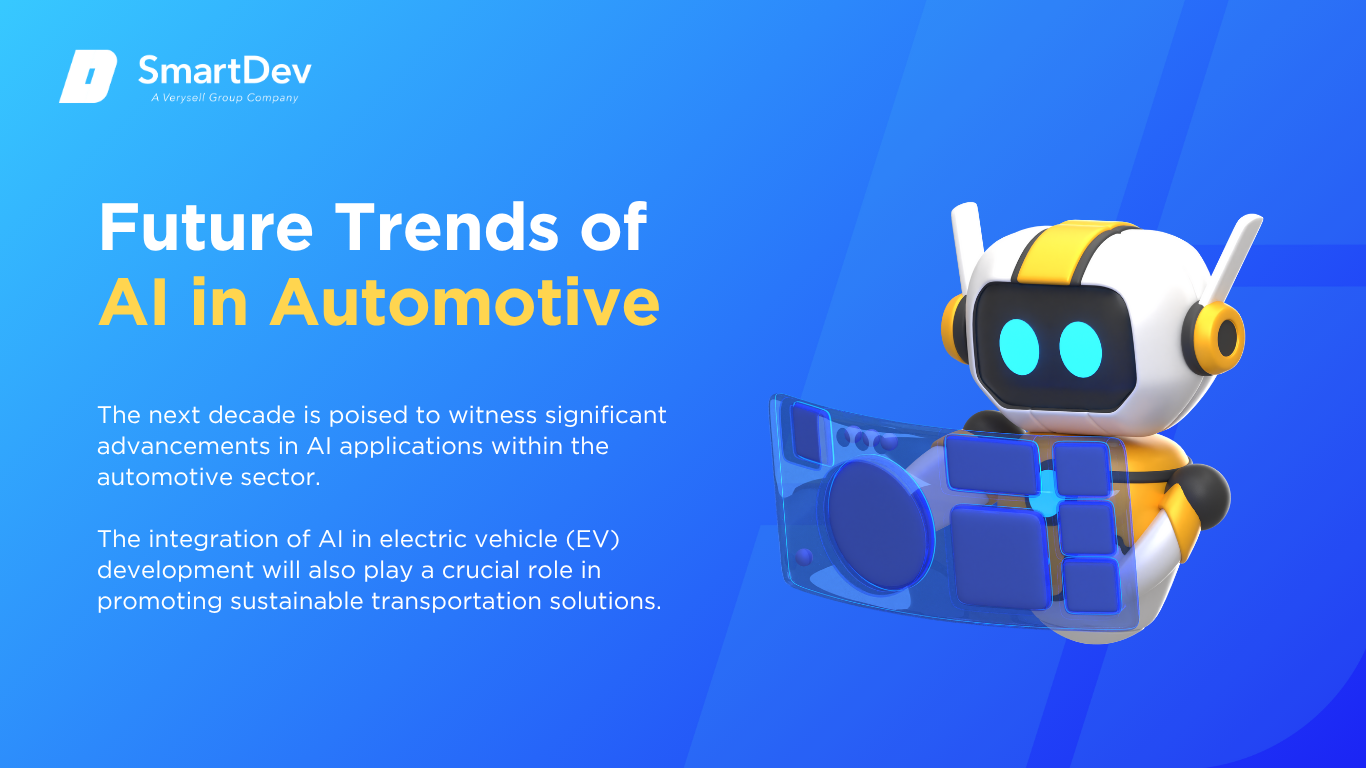
Predictions for the Next Decade
The next decade is poised to witness significant advancements in AI applications within the automotive sector. Developments in autonomous driving technologies, enhanced in-vehicle experiences, and AI-driven manufacturing processes are expected to redefine the industry. The integration of AI in electric vehicle (EV) development will also play a crucial role in promoting sustainable transportation solutions.
Moreover, the proliferation of connected vehicles will generate vast amounts of data, enabling more sophisticated AI models to deliver personalized services, predictive maintenance, and real-time decision-making capabilities. These innovations will not only enhance user experiences but also contribute to operational efficiencies and cost savings.
How Businesses Can Stay Ahead of the Curve
To remain competitive, automotive businesses must proactively embrace AI technologies and foster a culture of continuous innovation. Investing in research and development, forming strategic partnerships, and staying abreast of emerging trends are essential strategies. Companies should also prioritize agility, allowing them to adapt quickly to technological advancements and market shifts.
Engaging with industry forums, participating in pilot programs, and collaborating with tech startups can provide valuable insights and opportunities for growth. By positioning themselves at the forefront of AI adoption, automotive businesses can drive transformation and secure a sustainable competitive advantage.
Conclusion
Key Takeaways
AI is revolutionizing the automotive industry by enhancing design processes, optimizing manufacturing, improving customer experiences, and promoting sustainability. Through applications like generative design, computer vision, predictive maintenance, and energy optimization, AI delivers tangible benefits, including increased efficiency, cost savings, and environmental impact reduction.
Successful implementation of AI requires a strategic approach, encompassing readiness assessment, data management, tool selection, pilot testing, and employee training. Monitoring key performance metrics and learning from real-world case studies help in measuring ROI and refining strategies.
Moving Forward: A Path to Progress
As AI redefines the automotive industry, manufacturers, suppliers, and dealerships have a powerful opportunity to drive innovation, streamline operations, and deliver smarter, safer mobility experiences. From predictive maintenance and generative design to AI-enhanced manufacturing and intelligent sales tools, strategic AI adoption is quickly becoming the key to staying competitive.
At SmartDev, we specialize in building tailored AI solutions that empower automotive businesses to accelerate time-to-market, reduce costs, and enhance customer engagement. Whether it’s computer vision for quality control or AI-powered analytics for supply chain optimization, our experts partner with you to implement intelligent systems that align with your business goals and technical landscape.
Contact us today to explore how AI can future-proof your automotive operations and position your business at the forefront of the next industrial revolution.
—
References:
- AI in the Automotive Industry: Use Cases and Trends (2024) | Salesforce
- 75% of Automakers Plan to Integrate GenAI Into Vehicles This Year | PYMNTS.com
- Ford Looks to Innovate Faster With AI Agents and Nvidia GPUs | The Wall Street Journal
- GM taps Nvidia to boost its embattled self-driving projects | The Verge
- Global AI in Automotive Market | market.us
- Automotive Artificial Intelligence (AI) Market Size, Share, and Trends 2025 to 2034 | Precedence Research
- Snowflake Drives the Future of Automotive with New AI-Powered Solutions | Snowflake
- Top 5 Use Cases of Generative AI in the Automotive Industry | NexGenCloud
- Capturing Real-World Value in Automotive AI | Boston Consulting Group
- From engines to algorithms: Gen AI in automotive software development | McKinsey & Company
- Top 5 AI Use in Automotive Industry Case Studies [2025] | DigitalDefynd
- AI in the automotive industry heightens ROI | ROCK







